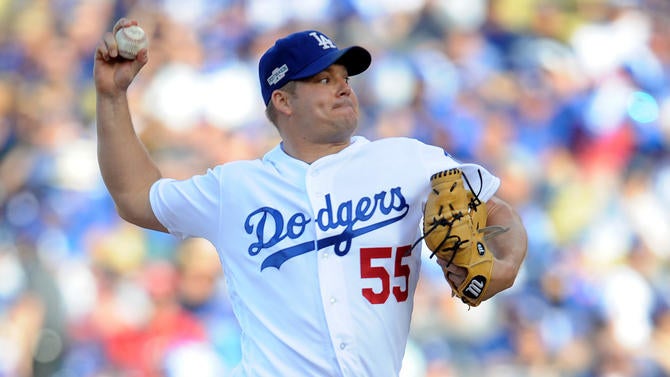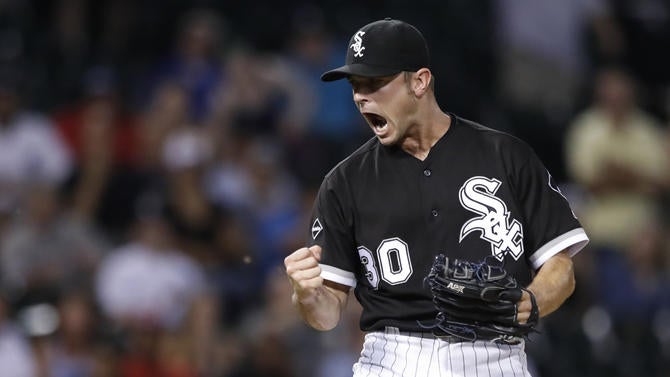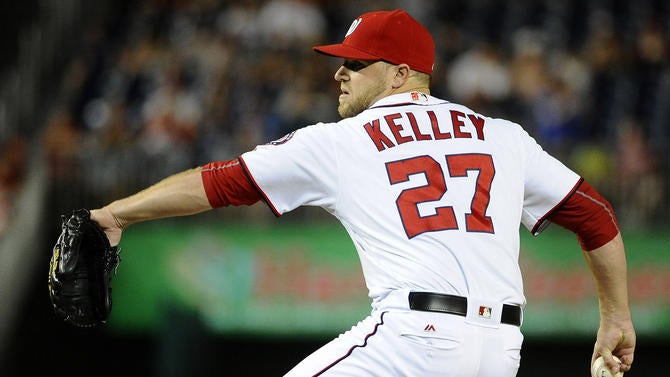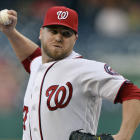Earlier this week, the Rockies scooped up the best remaining free-agent reliever when they agreed to a one-year contract with former All-Star closer Greg Holland. Holland hasn't pitched since September 2015 due to Tommy John surgery.
Among the other clubs connected to Holland were the Washington Nationals, who were involved in just about every big free-agent closer this offseason. They were in on Aroldis Chapman before he signed with the Yankees, Kenley Jansen before he re-signed with the Dodgers and Mark Melancon before he signed with the Giants. Obviously, they landed none of them.
The Nationals started last season with Jonathan Papelbon in the ninth-inning role and finished it with Melancon as their closer following a midseason trade with the Pirates. Papelbon was released and Washington hasn't added a new closer this offseason, meaning a team that fancies itself a World Series contender currently has an opening in the ninth inning.
Based on their hot stove activity -- i.e. not going all out to sign Chapman, Jansen, Melancon or Holland -- the Nationals don't seem to be overly concerned about their closer situation. Would they like to improve their bullpen? Of course. Every team would. But the market didn't present anything that made sense, so they didn't act. They had a plan and stuck to it.
So, with the offseason coming to a close and spring training less than three weeks away, let's sort through Washington's ninth-inning options. None are great, but many represent an upgrade to the team overall.
Available free agents

There are no closers left in free agency. No one who held down a ninth-inning job at some point last season. Just about every unsigned reliever at this point comes with some sort of red flag, either injury or poor performance or something else.
Could one of these five guys interest the Nats as a ninth-inning option?
Although his postseason didn't go well, Joe Blanton had a very good season as Jansen's setup man with the Dodgers. He threw 80 regular-season innings with a 2.48 ERA (158 ERA+) and 80 strikeouts. Blanton was all but retired two seasons ago, but he returned in 2015 and reinvented himself as a slider-heavy reliever. He's probably the best available free-agent reliever at the moment.
David Hernandez has not quite been the same since having Tommy John surgery in 2014, though he was solid with the Phillies in 2016, pitching to a 3.84 ERA (108 ERA+) with 80 strikeouts in 72 2/3 innings. He has some closing experience -- Hernandez saved 11 games with the 2011 Diamondbacks -- though not much. I'm not sure how much experience matters anyway. We see veteran closers fade and young closers emerge every single year.
Even at 42, Joe Nathan is still looking to pitch in 2017. His agent confirmed it earlier this winter. Nathan was active last summer, throwing 6 1/3 scoreless innings with the Cubs and Giants, though it has been a few years since he was healthy and effective. In 2014, his last full healthy season, Nathan had a 4.81 ERA (81 ERA+) with 54 strikeouts in 58 innings for the Tigers. He also saved 35 games. On the bright side, Nathan will almost certainly take a minor-league deal, so it's a no-risk move. Bring him to camp and see what happens. If he looks good, keep him. If not, cut him loose.
Aside from Nathan, Sergio Romo has the most closing experience among the remaining unsigned free agents. He has worked the ninth inning on and off for the Giants over the years, and was the closer for their 2012 World Series run. Romo struck out 33 with a 2.64 ERA (157 ERA+) in 30 2/3 innings around an elbow issue last season. The year before he had a 2.98 ERA (129 ERA+) with 71 strikeouts in 57 1/3 innings. Romo is still only 33, so he's not exactly over the hill.
Earlier this week I identified Fernando Salas as a potential bargain free agent because he misses bats with three pitches and has no platoon split as someone who can get out both righties and lefties. Salas even has a little closing experience -- he saved 24 games with the Cardinals in 2011. Not the sexiest name, I know, but at this point, there are few clearly superior alternatives available in free agency.
Possible trade targets

The bullpen trade market has exploded over the past 15 months or so. We've seen guys like Chapman, Andrew Miller, Ken Giles and Craig Kimbrel traded for monster prospect packages. I thought the Nationals did really well to get Melancon for lefty Felipe Rivero and a non-top prospect at the trade deadline last year. Compared to what Miller and Chapman fetched, getting Melancon at that price was a steal.
Here are some possible closer trade targets for the Nationals:
The Rays are always willing to trade players for prospects, regardless of their place in the standings. Drew Smyly and Logan Forsythe were traded away in recent weeks, so Tampa Bay is still open for business. Alex Colome saved 37 games with a 1.91 ERA (213 ERA+) and 71 strikeouts in 56 2/3 innings last season, and the Rays figure to move him soon. Colome will be arbitration-eligible next offseason, and as a closer with an All-Star Game selection to his credit, he's about to get expensive. The Rays don't pay big for relievers. Colome is definitely available.
The Athletics, like the Rays, are always open to moving their best players. Ryan Madson was Oakland's primary closer last season -- he threw 64 2/3 innings with 49 strikeouts and a 3.62 ERA (110 ERA+) -- mostly because Sean Doolittle battled injuries. Doolittle had a 3.23 ERA (124 ERA+) with 45 strikeouts in 39 innings. As the Adam Eaton trade showed, the Nationals like the idea of long-term contractual control, so it's worth noting Doolittle is owed $7 million total the next two seasons with affordable club options for 2019 and '20.
This offseason the Marlins have built what could be a deep and dominant bullpen. They have so much reliever depth that they could trade A.J. Ramos, their incumbent closer, and not really miss him. Free-agent signee Brad Ziegler could take over in the ninth inning while someone like Nick Wittgren or Brian Ellington gets the vacated roster spot. Ramos had a 2.81 ERA (140 ERA+) with 73 strikeouts in 64 innings in 2016, and he's not cheap. He'll earn $6.55 million in 2017 with two more years of arbitration eligibility to go. That might be too pricey for the Marlins and just right for the Nationals. Would the two NL East rivals hook up for a trade?
It's no secret the White Sox are now in the middle of a full-blown rebuild, and the last thing a bad team needs is an expensive closer. David Robertson is owed $25 million over the next two seasons, and if the White Sox could unload that salary and add more prospects, I'm sure they would do it. He had a 3.47 ERA (116 ERA+) with 75 strikeouts in 62 1/3 innings last season, which represents Robertson's worst season in several years. The Nationals and White Sox already hooked up for the Eaton trade, so Chicago is presumably already familiar with Washington's farm system. It might not take much work to get a deal done.
Even after acquiring several veteran starters to improve their chances of being respectable in 2017, the inaugural season of SunTrust Park, the Braves reportedly continue to make Arodys Vizcaino available in trades. He threw 38 2/3 innings with 50 strikeouts and a 4.42 ERA (94 ERA+) around an oblique injury last season, which represents his biggest MLB workload to date. Health has long been an issue for Vizcaino, who is already three seasons away from free agency despite throwing only 94 2/3 career innings in the big leagues. As with Ramos, could two NL East rivals get together for a deal?
In-house options

Doing nothing is always an option. Sometimes the best option. The Nationals could stick with the guys they already have in the organization and see how things shake out during the season. After all, four of the 10 postseason teams a year ago changed closers at midseason (Nationals, Giants, Cubs, Rangers). It's a volatile position.
Here are Washington's best in-house closer options:
The 23-year-old Koda Glover was the second 2015 draftee to reach the big leagues, behind only White Sox righty Carson Fulmer. Glover annihilated the minors, striking out 104 with a 2.09 ERA in 86 innings, though his first taste of the big leagues didn't go too well. He had a 5.03 ERA (84 ERA+) with 16 strikeouts in 19 2/3 innings for the Nationals. That's OK. Lots of guys struggle when they first get to the show. Glover is viewed as Washington's closer of the future. Can he be their closer of the present?
Shawn Kelley, a free-agent pickup last offseason, saved seven games for the Nationals a year ago, when Papelbon spent time on the disabled list. Kelley quietly had a 2.64 ERA (159 ERA+) with 80 strikeouts in 58 total innings in 2016, and he is currently the odds-on favorite to open the 2017 season as Washington's closer.
Even though he's prone to the occasional meltdown, Blake Treinen still managed a 2.28 ERA (184 ERA+) with 63 strikeouts in 67 innings in 2016, and his turbo-sinker produced a 65.9 percent ground-ball rate. Among pitchers to throw at least 60 innings last year, only the incomparable Zach Britton had a higher ground-ball rate (80 percent). Treinen is a Dusty Baker favorite and a stealth closer candidate.
As you can see, free agency doesn't have much to offer, though there are several appealing trade candidates, so Nationals general manager Mike Rizzo could go in that direction if he's not comfortable with his in-house options. Adding a setup man like Blanton or Romo to pair with Kelley until Glover is ready for ninth-inning duty is the easy answer, and is probably the best move long-term.
Clearly, the Nationals are thinking about the short-term. They want to win right now, while Max Scherzer is in his prime and Bryce Harper is still with the team. (Harper will be a free agent after 2018.) Playing it safe with Kelley until Glover is ready might not be the best move for a team trying to win a title. In that case, using more prospect capital to acquire a veteran ninth-inning guy like Doolittle or Robertson might be Rizzo's best plan of attack.





































